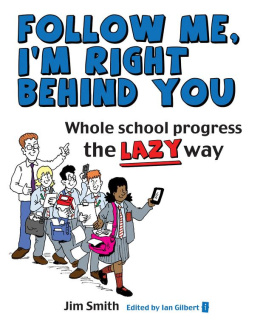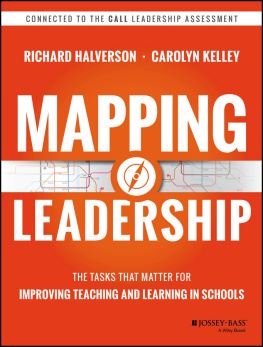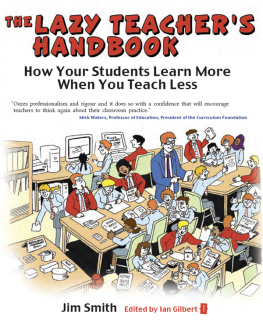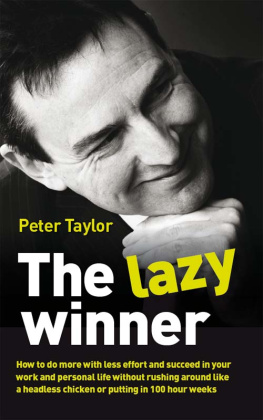Praise
Jim Smith has done it again. He has picked up the approach from his first book and pushed it right to the core of the current educational buzz word: progress.
Progress has become one of those words which it is easy to say, but harder to treat with respect. Hence it risks being treated with lip service by pupils, by teachers and at whole school level as people look over their shoulders at those who are watching them. This book cuts through all that, and offers a wealth of ideas for treating the word progress seriously and ensuring that pupils have a chance of making some and knowing they have.
Using the techniques of his first book, Jim offers idea upon idea in a way that is entirely accessible. The Lazy bit is again a misnomer but the book does show how thinking teachers and school leaders can make their jobs enjoyable and reap the rewards for effort that makes sense.
Mick Waters, Professor of Education,
Wolverhampton University
A welcome sequel to Jim Smiths first book, and again jam-packed with ideas for invisibly transferring the learning load onto students this time with an emphasis on whole-school processes. Readable, amusing and quirky, I expect this to do as well as its predecessor.
Barry J. Hymer, Professor of Psychology in Education,
Education Faculty, University of Cumbria
Following the success of his first book, The Lazy Teachers Handbook, Jim Smith continues his exploration of ways in which everyone involved in schools, from NQTs to senior leaders, is responsible for ensuring that learning and progress are at the heart of the business of teaching, the Lazy Way.
Of interest to any practising teacher, the thorny issue of lesson observations is unpacked and the process of demonstrating outstanding teaching demystified. He looks in particular at what is meant by progress and how this can be planned for, and then demonstrated, within a lesson observation. Importantly, however, he doesnt lose sight of the fact that teaching is a highly interpersonal activity carrying many rewards beyond a successful Ofsted grade.
When looking at professional development for teachers, the Lazy Way encouraging teachers to take responsibility for their own development is proposed and new approaches to CPD and performance management are suggested. At the heart of this lies the belief that teachers are highly skilled professionals with the potential to innovate, provided they are given the opportunity.
Still a practising teacher himself, Jim Smith writes with authority and also with respect for both the young people that he teaches and the colleagues with whom he works. Underpinned by a clearly articulated paradigm and written in a refreshing, engaging and accessible style, punctuated with examples drawn from his own work and from his extensive experience of working with a range of schools, this book speaks to anyone who is (or will be) part of a busy staffroom and who seeks more than a set of tips for teachers.
Jayne Prior, Senior Teaching Fellow in Education
and Director of Educational and Professional Studies
(PGCE), University of Bristol
Being a self-confessed fan of the Lazy Way and having read The Lazy Teachers Handbook, seen Jim Smith deliver INSET and been fortunate to visit the home of Lazy Teaching in Clevedon, I greeted this book with a measure of excitement and a dose of Ofsted weary cynicism. Excitement at the idea of more offbeat, yet enormously effective, strategies for delivering effective progress in my classroom; and cynicism at the potential for the approach to have taken on the age old appearance of simply being last years educational fad.
Fortunately, I am writing this with yet more excitement and not a trace of cynicism. The book and its author maintain a sense of infectious enthusiasm, wonderful humour and genuinely intelligent comment on the educational landscape in 2012, allied to a rock solid approach to dealing with the challenging concept of ensuring every child makes progress in every lesson they encounter.
It is written in an easy, flowing style which allows you to take ideas on board and see how they relate to both current Ofsted requirements and contemporary educational thinking in general. It contains a constant stream of useful tips and strategies which can be adopted wholesale or picked carefully and adapted to your, and your classs, own style.
The lesson model provides real scope for development in your own school, whilst maintaining its theme of children developing the capacity to understand the concept of checking their own progress. Whilst the book attempts to be light-hearted and humorous, it addresses very real and very complex issues. It does this without being flippant or patronising and constantly recognises that teaching should be a job which teachers should thoroughly enjoy!
The book covers the use of data, effective lesson observation and the development of a whole school Lazy ethos. All are brought into the overall approach in a simple, sharp and rational manner which seems to make perfect sense. The seemingly endless, practical strategies which litter the text add to the feeling that you are reading a genuinely relevant and useful manual for teaching today.
The book is a thoroughly enjoyable, suitably humorous and endlessly useful read. It is a natural step from The Lazy Teachers Handbook and takes the concept of Lazy Teaching out of the classroom and into the whole school.
Congratulations on another inevitable success, Jim.
Mind you Im sure hes nicked a couple of my ideas!
Geoff Cherrill, Vice Principal, Nova Hreod, Swindon
To Wendy, Henry and Oscar
Contents
This book would have still been so many ideas on bits of paper had it not been for the success of the first book. Hence, it seems appropriate to start by saying thank you to all those who have grasped the idea of being lazy and in one case demanded another book. I hope you like it, Mum!
It takes a team of people to turn lots of educational ideas on scraps of paper into a book, especially when some of the team may accuse me of following my Lazy Way when it comes to publishing as well as teaching! Therefore I want to acknowledge the work of Ian Gilbert who, in between sending pictures of some new amazing Chilean landscape, also finds time to guide, inspire and edit my thinking. Likewise, Caroline Lenton and the team at Independent Thinking Press. Caroline has offered unwavering support and encouragement (although without the amazing pictures).
Whether it is my day job based in school or when I go out and about delivering the many INSET and Conference sessions I do, I am lucky to have different roles that continually provide me with the stimulus for ideas that are grounded in educational reality. So a huge thank you to my colleagues, delegates and of course the students, without whom we would never know if the ideas actually make a difference. Individual mention must go to Jamie Potter (Just Do It Wrong), David Didau (Learning Hexagons) and Gareth Beynon (Data Starts A Conversation) for offering ideas that really made me rush and write them down instantly.
As ever with a team it is those behind the scenes who play some of the most crucial roles. And in the case of Team Lazy it is no different. I owe a huge debt of gratitude to my gorgeous wife Wendy for her love, support and her regular doses of realism, which keep me grounded at all times (an excuse I often used during my off-days in the rugby lineout). Likewise our two boys, Henry and Oscar, for constantly reminding me what the most important thing in life is, as well as showing me just how amazing and quick learning can be even if it does mean regularly coming third when we play games these days. To all three of you, not only a massive thank you, but an even bigger I love you as well.






